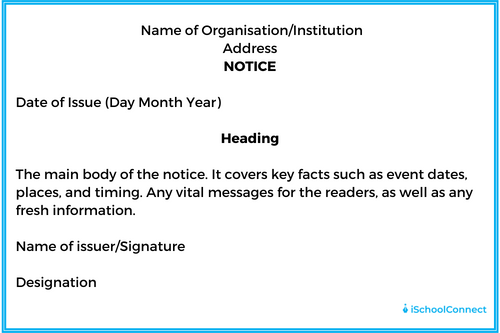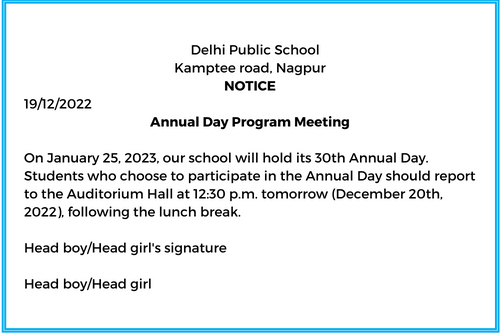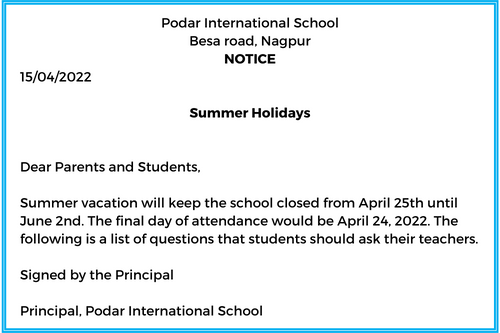Table of Contents
What do we understand by notice writing?
Students may have heard the term “notice” several times, but what does it signify, and how can they identify a notification? Notice writing is a formal communication strategy to transmit news or information to a big group. They are a vital communication medium employed in various settings, including academic institutions, professional groups, events, government announcements, and so on.
Notices have recently become more common in the digital environment. With the digitization of every institution, such as schools, businesses, colleges, government offices, and even newspapers, spreading information online has become critical. Despite these modifications, the format of formal notice writing has remained consistent. However, before we get into the format, let’s look at the many forms of notification writing.
Notice writing | Know the format and structure
Notices are formal papers and should follow a structure or format. Remember, there is no one correct rigid format. Different formats employed by different people/organizations may exhibit some differences. However, it is best to adhere to a roughly comparable format for ease of comprehension and consistency. Let’s take a look at the most common notice format.
Name of issuing organization/authority: Print the name of the person or company that issued the notices at the top. It will assist the reader in determining whether the notices are relevant or unimportant to him.
- Title: When composing notices, we use “NOTICE” at the top. It aids in drawing attention to the document. Generally, notices are put in public places or published in newspapers. They mustn’t become lost in a sea of data. As a result, a prominently displayed title aids in attracting attention.
- Date: Following the tile on the left, we print the date on which the notices were published. As this is a formal document, the date is significant because these records are kept on file.
- Heading: Then we move on to a suitable heading for the notices. This headline should make the objective of the notices clear.
- Body: After the headline, we write the brief and to-the-point body of the notification. The body contains the notice’s major material.
- Writer’s name: At the end of the notices, we write the notice-name writer and designation. The notices must also be signed by the same person to be considered authoritative and authentic.
Here’s an example of how a notice should look-

Samples for notice writing
Here are some notice writing examples to help you understand how to follow the rules of formal notice writing.
- Example 1. If you are the Head Boy or Head Girl of a school and need to send out a notice about a meeting for the Annual Day celebration, here is how you do it.

- Example 2. If you are required to prepare a summer vacation notice along with some instructions, here is a sample you can use.

Tips for writing a notice
If you want full marks for notice writing, keep a few basic suggestions in mind. Let’s go over them.
- No details – Notice writing is about the specific facts you want the readers to know, not the details. When writing a notice, it is important to keep it brief but informative.
- Correct heading – Since the notification is meant for a big audience, they must comprehend the notice. To accomplish this, the writer must carefully select the notice’s heading.
- Structure – The writer must adhere to the notification format. Use a bold font for the organization’s name and a smaller type for the next two lines, which contain the term ‘notice’ and what the notice is about. It is done to call attention to it. The body of the message should be written in smaller font size. End the notification with the individual issuing the notice’s signature, followed by their designation in block letters.
- Clarity – Even though notices are intended to be brief, you must make it apparent to readers what the notice intends to express. If the notice’s message is unclear, it may confuse the viewers.
Key takeaways
- Maintain your notice crisp and concise. Avoid fluff and strive to keep the body’s word count around 50 words.
- To avoid confusion, accurately mention the notice’s header, describe what the notice wishes to address, and address the notification to the appropriate people.
- If you need to mention a venue or a certain time, do it separately so readers can easily notice it.
We hope this article gave you the information you need to write a notice. Also, visit the ischoolprep website to read more such interesting blogs.
Like this blog? Read next- Basic English grammar rules | 5 best ones to take note of!
FAQs
Question 1. What is the primary function of a notice?
Answer: A notice’s goal is to announce or display information to certain individuals.
Question 2. How is notice writing useful?
Answer: You may be asked to write a note at your company or anywhere else. You may even need to send out notices in an official context, in which case the notice writing structure outlined above will assist you in effectively conveying your message.
Question 3. What should things be avoided when writing notices?
Answer: A notification is written in the third person; consequently, avoid using personal pronuns like I, you, me, etc.






